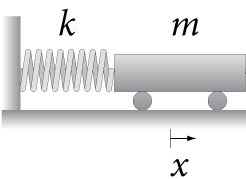ESTM Challenge
Challenge: We predicted the compression of two springs with different spring constants so that the two carts come with the same velocity.
Procedure: The only data we took was the mass of the two carts (.544 kg for the cart with the blue spring and .552 kg for the cart with the red spring). We were given the spring constants of each spring (112 N/m for the blue spring and 84 N/m for the red spring). We than calculated for the compression of the spring needed. After we calculated the compression for each spring, we tested our predictions using the motion sensors to detect the velocity of each cart.
Diagram:
To solve for the compression we used the energy conservation equation Eel = Ek. We did not consider friction so this equation was appropriate to use in this situation. Our work is shown below.
Conclusion:
Once we calculated the compression of the two springs, we tested our predictions using motion sensors and PASCO Capstone. We analyzed the velocity vs. time graphs to examine the velocities of the two carts. The cart with the red spring traveled at around 0.47 m/s and the cart with the blue spring traveled at around 0.41 m/s. Our prediction was off by about 6.8%.













